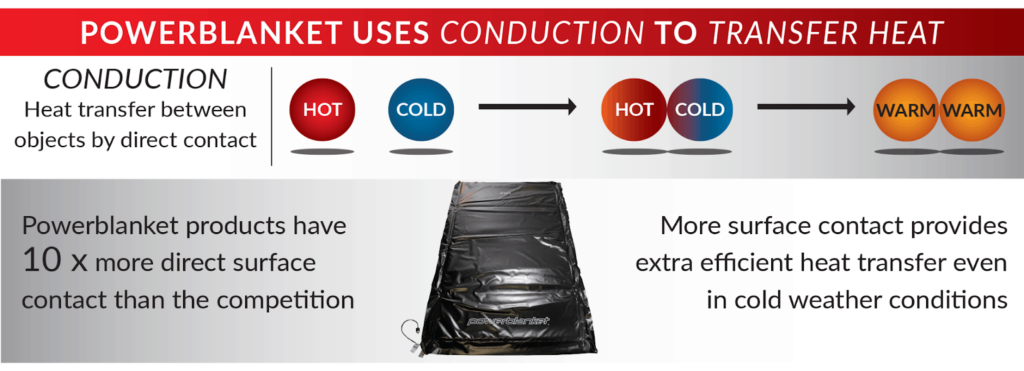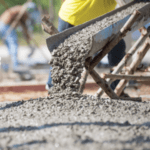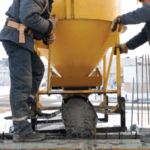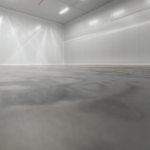What Is an Insulated Tarp?
Insulating tarps offer efficient and simple ways to regulate temperature. Cold weather can prove detrimental to construction projects. Low temperatures can offset curing times and the final strength of materials like concrete. Insulated tarps are often one of the first solutions that come to mind to battle cold weather conditions.
How Do Insulated Tarps Work?
Insulated tarps work by trapping a layer of air between the tarp and whatever it is covering. This air acts as insulation and helps to keep whatever is underneath the tarp warm or cool depending on the needs of the application.
Insulated tarps have long been an essential tool for construction workers, pipe layers, gardeners and other professionals. The main function of an insulated tarp is to trap in heat underneath, letting as little heat out as possible. This is important in protecting items like kilns, machinery, and other materials that rely on heat to ensure operations remain functional and materials cure properly.
Insulated tarps are often used for curing concrete as it helps to maintain a consistent temperature which can speed up the curing process. Concrete hardens faster and stronger at higher temperatures when compared to concrete that has cured while exposed to cold temperatures.
Insulated tarps are used for many other applications besides curing concrete. They are often used to protect items in cargo containers during shipping, outdoor activities such as tailgating or picnicking and can even be found covering greenhouses in commercial agriculture. You can find them all over the world where protection against the cold is needed.
Do Tarps Protect Against Heat?
Insulated tarps protect against cold, but since tarps don’t produce heat they also somewhat protect against materials getting too warm. Insulated tarps, as the name implies, have a layer of insulation in between layers of tarp. This insulation resists heat loss in low temperature environments and also has some effect against warm temperatures as well. However, they are much more effective at minimizing heat loss than protecting against heat. (Find out more here: electric vs insulated blankets.)
Types of Insulated Tarps
Insulated tarps are made from cheap materials which allow them to be manufactured at low cost. However, a high-quality insulated tarp is often made with highly durable material that will last through all sorts of weather. Though tarps may vary in production methods and styles, generally they are made of one of the following materials:
- Polyester is the cheapest type of insulated tarp due to its low cost of production. It’s the most common type of insulated tarp, though it is prone to wearing out when exposed to raw sunshine over long periods of time.
- The other kind of insulated tarp is closed-cell foam. Often described as the best type of insulation, closed-cell foam tarps rely on trapped foam bubbles that don’t allow heat or moisture to pass through.
Pros and Cons of Insulated Tarps
Pros of Insulated Tarps:
- Insulated tarps slow down heat loss substantially when compared to not using a tarp at all.
- Initial weather-resistance: tarps block out rain and snow for some time, though usually the tarp wears out when left exposed to the elements for longer lengths of time.
- Tarps are easy to install and remove.
Cons of Insulated Tarps:
- Plastic tarps tend to break down when exposed to sunlight. Ultra-violet light from the Sun will damage the tarp and break down the protective layers that had been protecting your materials.
- Wind and dust can further damage insulated tarps, wearing down the tarp surface and edges until it tears. For the most part, tarps are only water-resistant, meaning any tears that form will leak water onto sensitive materials and equipment.
- Lack of warming capability.
In summary, insulated tarps are made for quick fixes and are not a long-term solution for material warming and cold weather mitigation. Tarps just aren’t meant to last more than a few uses and cannot provide additional heat when needed.
Alternatives to Insulated Tarps
Not all tarps are made equal, but all of them suffer from distinct disadvantages such as inevitable heat loss, wear, and a lack of internal heating. These downsides can be detrimental to workplace operations when materials are already cold and need to be warmed up. An insulated tarp will not be helpful if you’re trying to increase temperatures.
Other options for heat loss mitigation include things like heat trace cable or space heaters, but both of these products don’t come close to the level of direct heat provided by curing blankets.
What’s the Difference Between Insulated Tarps and Concrete Curing Blankets?
An effective alternative to insulated tarps, concrete curing blankets actually provide heat instead of only preventing heat from escaping. Built from durable materials that can last years in broad daylight and in extreme weather conditions, concrete blankets exceed where insulated tarps fail.
But where curing blankets truly stand out is the ability to provide direct heat onto materials through the process of conduction. Through heat conduction, concrete curing blankets cure concrete 2.8 times faster than a typical insulated blanket while properly maintaining moisture throughout the hydrating process, even in cold weather concreting.
Additionally, concrete blankets are easily transported and installed. Each blanket maintains full ACI compliance for cold-weather concreting and are ETL certified to high electrical standards.
If you’re looking for a solution to maintaining optimum concrete cure time during cold weather, using a concrete blanket from Powerblanket is the best method for drying and curing concrete. Powerblanket’s curing blankets are also the best tool for other heat loss prevention solutions.
Powerblanket eliminates costly weather delays, ensures your project proceeds on schedule, and provides a curing solution that will be long-lasting and durable all through high quality temperature control products. Contact us to find the right heating solution for your needs 855.993.3057 or [email protected].
Frequently Asked Questions
What is the best tarp to keep cold out?
Insulated tarps are the best option for keeping cold out, as they are designed to trap heat and protect heat-sensitive materials from extreme cold conditions.
How effective are insulated tarps?
Insulated tarps are highly effective at significantly reducing heat loss and providing an initial barrier against rain and snow, although they may degrade with prolonged exposure to harsh weather.
What is the R value of an insulated tarp?
The R value of an insulated tarp is typically around R4 per inch, indicating its ability to resist heat flow and provide thermal insulation.
Will a tarp keep cold out?
While a standard tarp can block airflow and trap some heat, an insulated tarp is specifically designed to provide better insulation and maintain warmth in cold environments.
Cure your concrete faster and better in cold weather conditions with Powerblanket.






